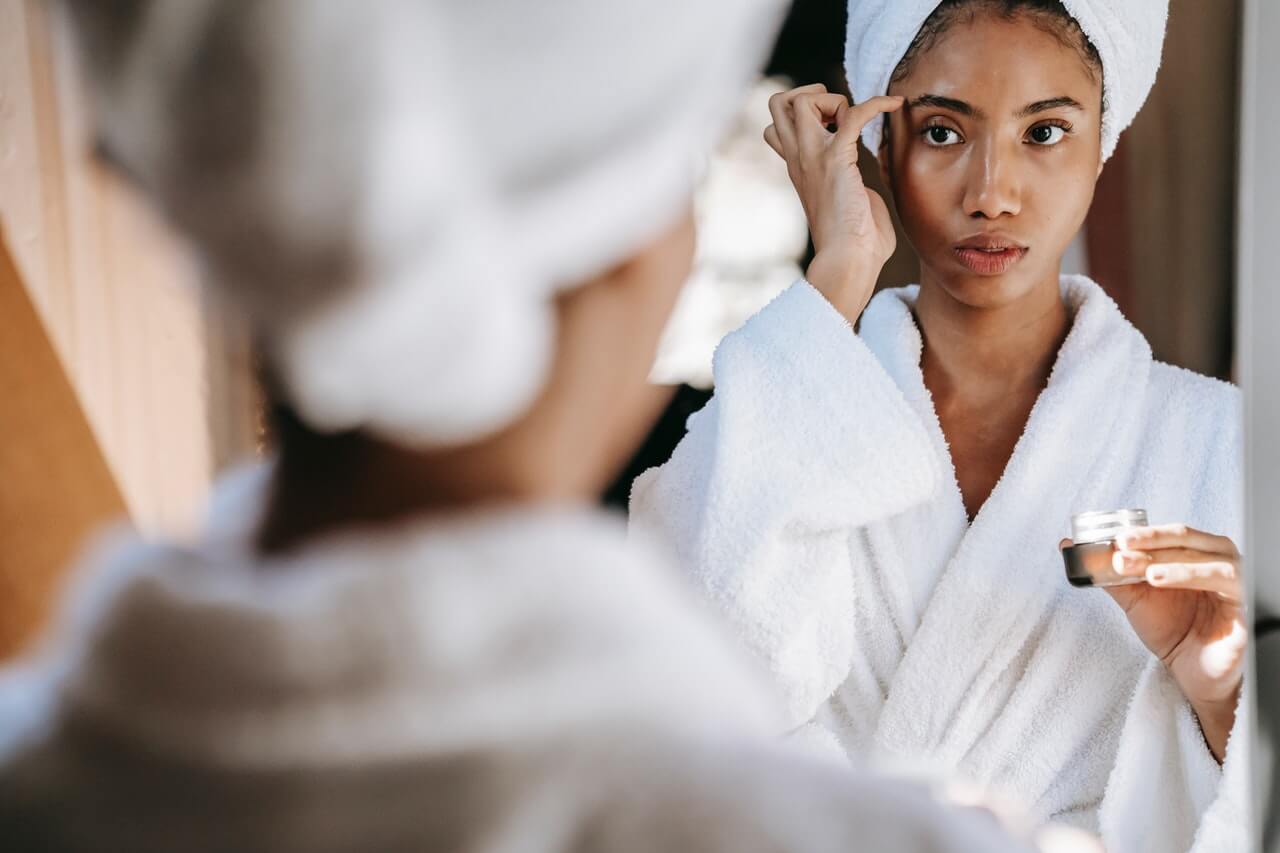What's the deal with hair and scalp pain? According to doctors, the reason your hair may feel like it's hurting can be due to inflammation in the scalp that's brought about by several common causes like styling or poor washing habits. Thankfully, there are several easy solutions to remedy the aching, including avoiding tight hairstyles, washing your hair more often and stimulating your scalp. Plus, learn more about the best scalp products for all scalp types.
#include-related-slider#
The Difference Between Scalp Pain and Hair Pain
The science behind hair pain starts in the scalp. “Hair pain, otherwise known as scalp sensitivity, occurs due to an inflammation of the blood vessels in your scalp," said Dr. Stephanie Nichols, a licensed naturopathic doctor. "Your hair does not actually hurt, which is why you don't experience pain when getting a haircut; rather, it is the perifollicular area around each hair and the nerves in your scalp that hurt.” In other words, while it feels like your hair is hurting, the pain actually originates in your scalp.
To echo that, Dr. David D. Clarke, M.D., explains that the sensations of pain we experience in our hair are really coming from the nerve endings attached to each specific hair. According to him, this nerve pain can be caused by two factors: "Pain could be coming from the underlying skin and might be due to inflammation of the skin, which would be visible as redness and possibly swelling, or from irritation of nerves leading from the affected area."
To delve into the science behind why we experience hair pain, Dr. Peter Bailey, M.D., shares that the primary reason for scalp aches is inflammation, which can occur for various reasons — from dandruff to allergic reactions to hair care products.
Try It Yourself: GRO Revitalizing Scalp Massager
7 Common Causes of Scalp and Hair Pain and What to Do About Them
Hair and scalp pain are caused by several different factors, each with its own solution. Keep reading to learn the possible reasons behind your scalp tenderness and what you can do to remedy it.
When Your Hair Is Dirty
Why it happens: Yeast overgrowth and dandruff
While it's healthy to avoid overwashing your hair, doing the opposite also comes with negative repercussions. In short, your scalp's natural oils continue to accumulate around the hair shaft, which in turn encourages the overgrowth of yeast on your scalp. This yeast buildup tends to lead to dandruff that manifests into inflammation, causing hypersensitivity that can feel like your hair is hurting.
Also: Can Lupus Cause Hair Loss?
What you can do about it: Nourish and stimulate your scalp.
A hair serum or a pH-balancing shampoo treatment can prevent yeast overgrowth and dandruff while nourishing your hair from its roots.
What's more, if you tend to go long periods of time without washing your hair, you can still maintain a healthy blood supply to your scalp while regulating excess grease from your oil glands by simply brushing your hair regularly. And on in-between days, a plant-based dry shampoo is your friend.
When You Keep the Same Hairstyle for a Long Time
Why it happens: Compression
Wearing your hair in any same style for days at a time, whether it's a ponytail, cornrows or braids, can contribute to feelings of tenderness and soreness around each hair follicle.
According to Dr. Bailey, keeping up the same hairstyle — or even a hair part — leaves your hair too accustomed to being in one position, which can cause sensitivity. As a result, “When you move your hair back the other direction, this can result in sensitivity or pain, as the nerve endings around the follicles are now being pulled a direction they aren't used to facing," he said.
Also: Smelly Scalp? Here's What You Can Do About It
What you can do about it: Switch it up, and brush your hair.
Dr. Bailey also suggests avoiding wearing any specific style for an extended amount of time, including overnight. This is so your follicles aren't forced in any one direction they wouldn’t normally lie, such as if you wear a ponytail for too long. "Before bed, let your hair down or put it in a loose bun to ensure this slow transformation of hair follicle direction doesn't take place."
If you don’t wash your hair and you keep it in the same style, it can feel sore because it lacks hair and scalp stimulation. If you’re that girl who has to go five days without washing, then brush your scalp. Use a Paddle Brush to rub the head and revive blood flow. Rearrange your hair direction too.
Also: How to Exfoliate Your Scalp
When You're Prone To Migraines
Why it happens: Allodynia
Did you know that two-thirds of those who suffer from constant migraine headaches also experience hair pain, according to the American Headache Society? That's because migraines can cause a phenomenon known as allodynia, which is when ordinary nonpainful stimuli feel painful. Allodynia is provoked by the constant firing of nerve cells in the brain during migraines. While it's not limited to the scalp, allodynia can cause increased sensitivity to your scalp and hair strands.
What you can do about it: Seek professional advice.
Consult with your medical doctor to find the best course of action.
Shop: Tenley Molzahn's Top Vegamour Pick
When You Wear Tightly Pulled Back Hairstyles
Why it happens: Scalp tugging
As much as Bella Hadid and Kim K make us want to rock a sexy slicked-back bun, these tightly pulled-back hairstyles can lead to major scalp pain, and even worse, traction alopecia, said Dr. Bailey. Traction alopecia is a gradual balding that occurs when your follicles become damaged by too-tight hairstyles.
At the very least, your tight hairstyles will lead to scalp tenderness from the prolonged pressure on the nerve endings at the root of your delicate hair follicles.
What you can do about it: Change the way you treat and style your hair.
To avoid alopecia, Dr. Bailey recommends sticking to soft rollers, rubber bands or hair ties (say goodbye to those tight, grippy elastics) and opt for looser hairstyles instead. And when it comes to styling your hair, consider opting for loose styles instead of anything that pulls at your precious scalp. Nighttime is no exception — sleeping with your hair tied up can result in some unwanted soreness.
You can also try GRO Hair Serum, which includes a unique combo of clinically-tested, plant-derived phyto-actives to soothe the scalp and revitalize hair roots.
Also: Do You Know Your Scalp Type?
When You Use Too Many Products
Why it happens: Product buildup
We all want perfect hair. But when we pile on several products at a time, we can block our follicles. This creates the perfect environment for bacteria to thrive, especially if you sweat, increasing the chances of inflammation, itchiness and pain.
Aggressive hair dyes and bleach can also cause major irritation and pain.
What you can do about it: Take a scalp detox.
Sometimes your scalp just needs a break! If you're constantly applying haircare products, refrain for a few days to give the skin and follicles in this area a chance to breathe and regulate themselves.
Also: 6 Signs You Need a Scalp Detox (And How to Do it)
When You Wash Your Hair Too Often
Why it happens: On the one hand, the scalp can hurt when hair is dirty. But on the other hand, the scalp hurts when you go overboard with scalp cleansing as well. By washing your locks daily and using harsh shampoos, you deprive your scalp of sebum and ruin its healthy pH. And dry skin is a straight road to flaking and itching, of course.
What you can do about it: Space out your wash days by using a dry shampoo.
One especially good pick is a dry shampoo that's fortified with phyto-actives that help support healthy and balanced hair follicles. Proper scalp cleaning with a purifying shampoo or a scalp scrub should be your weekly routine, but you have to customize the schedule based on your hair type. If you need to wash your tresses daily, choose milder products like baby shampoos or sulfate-free options to avoid drying out your scalp.
Learn: Dry Scalp and Oily Hair? Try This
When You Have a Bacterial or Fungal Overgrowth
Why it happens: Infection
If you're also dealing with bumps, scabs, and burning or stinging sensations, you might have an infection. The culmination of these factors — tight hairstyles, tugging on your hair, product buildup — can also be a sign of infections such as scalp folliculitis, aka a bacterial or fungal infection around the follicles on your scalp. According to Dr. Nichols, "Yeast, bacteria and mites may also cause folliculitis, which can cause pain or burning."
What you can do about it: Seek professional help.
Thankfully, there are several ways to remedy folliculitis. Consult with your medical doctor, a dermatologist or a trichologist to find out the best way to treat it.
Also: Read This Before Getting a Brazilian Blowout
So Can My Hair Really Hurt?
There you have it, the most common reasons your hair can feel like it's hurting. But it's not that your hair hurts. Instead, the pain is coming from your scalp. If your scalp pain persists after trying the above remedies or if you have a more serious scalp condition, the best course of action is to consult your doctor to help you get it resolved.
#include-related-slider#
More From VEGAMOUR
- What's Your Hair Texture and Hair Type? How to Find Out
- Read This Before Getting a Brazilian Blowout
- Does Wearing a Hat Cause Hair Loss?
- Seborrheic Dermatitis and Hair Loss Explained
Photo credit: Vlada Karpovich/Pexels
Back


















